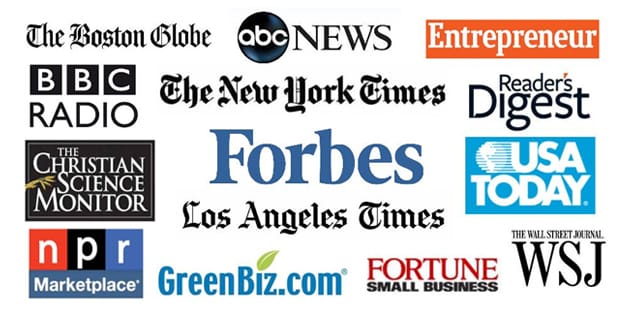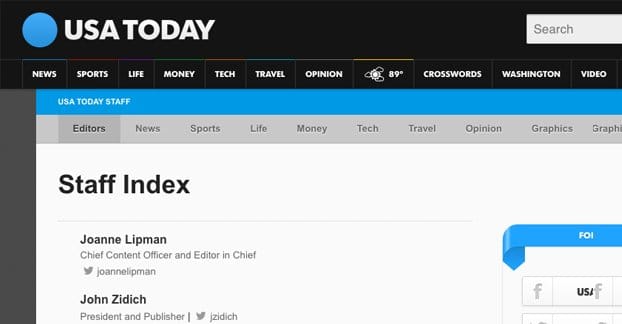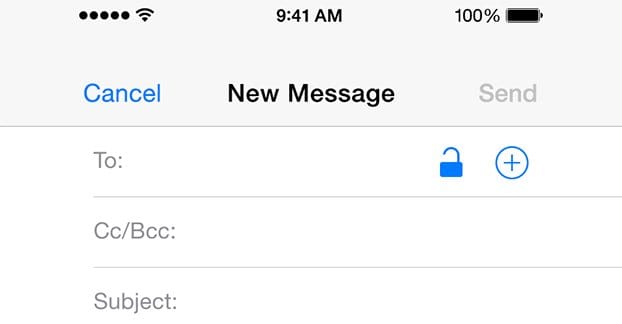While scouting for guest blogging opportunities, you’ve likely encountered a few sites that seem very promising, but have proven to be impenetrable. You have the right kind of content, you have high quality content, but no matter what you submit, you’re just stonewalled by the editor in question.
Most of the time, it’s nothing personal. The editor doesn’t hate you. They probably only vaguely know who you are. They might have checked out your profile and your site the first time you applied, dismissed you for one reason or another, and have since been ignoring you despite your repeated emails.
They don’t know you, and that’s the problem. You see yourself as a prominent figure, trying to network with this site. The editor sees you as just one of dozens or perhaps hundreds of people applying to write guest posts. It’s easy to ignore someone when all they are to you is an email address and a message or two per month.
In fact, a lot of the authors I know personally at places like USA Today, Forbes, and other big name sites got their gigs not because of their pitches, but because of their connections. It wasn’t a compelling email that got them in, it was shaking hands with an editor.
So how can you replicate this success? It’s not easy, and it’s not cheap, but it’s undoubtedly effective.
Step 1: Determine Your Target Sites
You’ve probably already done the legwork for this part, but maybe not, so I’m going to start from scratch. The first thing you need to do is figure out what sites you want to be guest posting for, but that aren’t willing to let you in.
Often, if you’ve followed my advice before, this will be a list similar to your tier 1 sites. They’re the hail mary style sites that you’d love to write for, but that are either swamped with submissions or have such high standards that it’s nearly impossible to get in. Forbes is one such site.
The trick here is that this is actually a process you do along the way. Every time you submit a pitch to a site that accepts guest posts, you get to re-categorize that site. Some of them will accept you, so they go in the contacts pile. Some of them will be interested but will reject the specific pitch; they’re on the pile of sites to revisit and pursue. Some of them will ignore you or reject you out of hand, and these are the sites you need to really think about.
Which sites are they? Would they be truly valuable to write for? Forbes would be, but some other random site in your niche might not be worth the trouble. The ones that aren’t worth the effort, you can put on a special list of people who might be worth trying again in a year, but aren’t worth actively pursuing.
Once you have your main list narrowed down to just the sites that are definitely worth pursuing, but that have ignored or rejected you, it’s time to start figuring out how to proceed.
Step 2: Identify the Relevant People
When you have a site you want to proceed with, you need to figure out who you need to talk to. I like to make a list of people, not just one target.
The primary target is obviously the managing editor, or the editor of the section of the site. For example, Forbes has people like Jennifer Rooney, the CMO Network editor, and Jeremy Bogaisky, deputy editor of business news.
Some sites will only have one head editor. Some will have a head editor and a few smaller deputy editors. Some will have a whole staff of editors for different channels. Forbes, since I keep using them as an example, has head editors for a lot of different channels. You’ll want to narrow down your search to the people who are in charge of relevant sections.
Now, you CAN meet up with the head of the fitness section on a site and get a connection about your marketing blog. You just have to ask them to pass along your information to the relevant coworker. This is, however, a less viable strategy for two reasons. First, they might not want to or be able to do that for you. Second, they might not like that particular coworker and wouldn’t want to give them any assistance. Office politics are alive and well even in online interactions.
Generally, you’ll have one primary target, who will be the managing editor of the section you want to write for, and the person responsible for accepting or rejecting you. Then you’ll have a list of secondary targets, who will be the most prominent staff members in the channel.
You can also target specific writers, either staff writers or other guest authors, but I wouldn’t go out of my way to reach out to them. Most of the time they don’t have much sway, if any.
So how do you actually identify the people in question? There are a few ways you can try.
- Check for a staff page for the site. Some sites will have a staff page that helpfully lists all of their editors and the methods you can use to contact them, like Business Insider. Some will just have generic contact information on a page, like Forbes.
- Check the channel for articles posted by people flagged as staff members. You can often see the role of the person posting and check to see if they’re an editor. Some site editors don’t post much, though. This feed from Forbes is mostly made up of content from staff members.
- Run Google searches for <sitename>”editor” or “managing editor” or other such keywords. Variations on editor, staff, and manager are all good keyword ideas. Just make sure to filter out content ABOUT those. You can also examine the URL structure of staff profiles on the site and filter search results that way as well.
- Search Twitter for people who have <sitename> editor in their bio. Twitter’s search is pretty robust for this kind of thing.
- Search LinkedIn for the site profile and see who is connected as an employee. Not everyone will be using LinkedIn, and sometimes these people will see that you’ve investigated their profile if they’re paying for advanced profile access, so keep that in mind.
One thing you need to do before you run with this data, though, is make sure it’s up to date. More than once, I’ve found an out of date LinkedIn or Twitter profile from someone who was an editor but was demoted or left. It does you no good to contact someone who no longer works for the site.
Step 3: Find Opportunities to Meet
This is by far the hardest part, and for some people, it will actually be impossible. What you need to do is essentially stalk your target. Look up their social media profiles, their editor profiles, any content channel they post on or use frequently. Keep an eye on these channels and look for any time the person in question talks about going to an event, trade show, or other public meet-up.
Now, you don’t want to be an actual, legally-punishable stalker. If your target editor talks about going to see a movie, you don’t want to interrupt their family night out to talk about business. It very much does not help your cause if the editor in question takes out a restraining order on you.
The problems you’ll encounter are common and not easily circumvented.
- The editor might not use their social media much, or it might be locked down such that only friends can see what they post about. This doesn’t give you much ability to access their schedule, and you probably shouldn’t try to friend them on Facebook for this kind of reason.
- They might be active on social media but don’t talk about where they’re going until it’s too late. It doesn’t do you any good to find out an editor is going to CES when they’re already at CES and you aren’t there.
- They might be active on social media but don’t really go to events. You can’t meet them somewhere if they don’t go anywhere for you to meet.
- They might go to events that have exclusive guest lists. E3, the video game conference, spent a few years only open to members of the press, and it could be pretty difficult to qualify for a pass. They’ve rolled back on some of that now, but other events are still only accessible to members of the press or to owners of businesses in a certain niche. If you don’t qualify, you can’t get in.
- They might have an event they’re going to that you could go to, if you simply had the budget to do it. This is probably one of the biggest pitfalls of this method overall, actually. You need to be able to afford to take a few days off, fly out to some exotic location, buy a pass for the event, rent a hotel room, attend the event, and all the rest. If you can’t afford it, you can’t go out to meet people.
If you’re in luck, you’ll find someone who is attending an event you can actually attend, and you can try to find them at the event.
Step 4: Meet, Introduce, and Talk Casually
The next part is, for some people, the hardest one of all. For others, it’s easy. All you need to do – and I make it sound trivial – is find the editor at the show and meet them.
Some of these editors will be reclusive, not posting about what they’re doing, so they’ll be hard to find. You either have to reach out to them on social media and ask to meet up, or get lucky and find them somewhere in the halls of the event center. Some editors will be “liveblogging” their experience, to build social media followers and to get cutting-edge information out there. This will make them easier to find, as long as you react quickly and can recognize them. It’s even easier if they willingly say “hey meet me here if you’re around!”
And, of course, some of you reading this will be natural extroverts who love meeting new people. It’ll be a snap to go up and say hi. For others of you, the introverts who have trouble with new social situations, it will take a lot of courage to not be an awkward mess or let your opportunity slip by.
Now, when you actually meet with them, you need to use your best judgment. You shouldn’t lead with “hey I’m trying to guest post for your site, can you help me?” You’d be starting up with a favor, and that puts a sour taste in their mouth. Instead, you need to introduce yourself and talk about the event. Just shoot the breeze, let them guide the conversation, and have a good time. If the opportunity to talk about work comes up, go ahead. If not, don’t worry about it. The important part is to talk to them and leave a good impression.
Get their business card. Worry about guest posting later; for now, just open a dialog.
Step 5: Follow Up Later
The finale, where this all pays off, comes later. You will need to pick a time that feels right and reach out to the editor via a personal connection. An email, a Twitter message, whatever works best for the situation. You can do this an hour or two after you’ve met them, or a day later, or a week later, but I wouldn’t wait much longer than that.
What you do is remind them who you are and that you met, and ask them if they have any interest in publishing your content. Essentially pitch a guest post, but instead of relying on your references, you have a personal connection to mention as well. Ideally, they will be associating you with a pleasant conversation and will be more likely to say yes. It’s not guaranteed, of course, but nothing in life is.
 ContentPowered.com
ContentPowered.com









